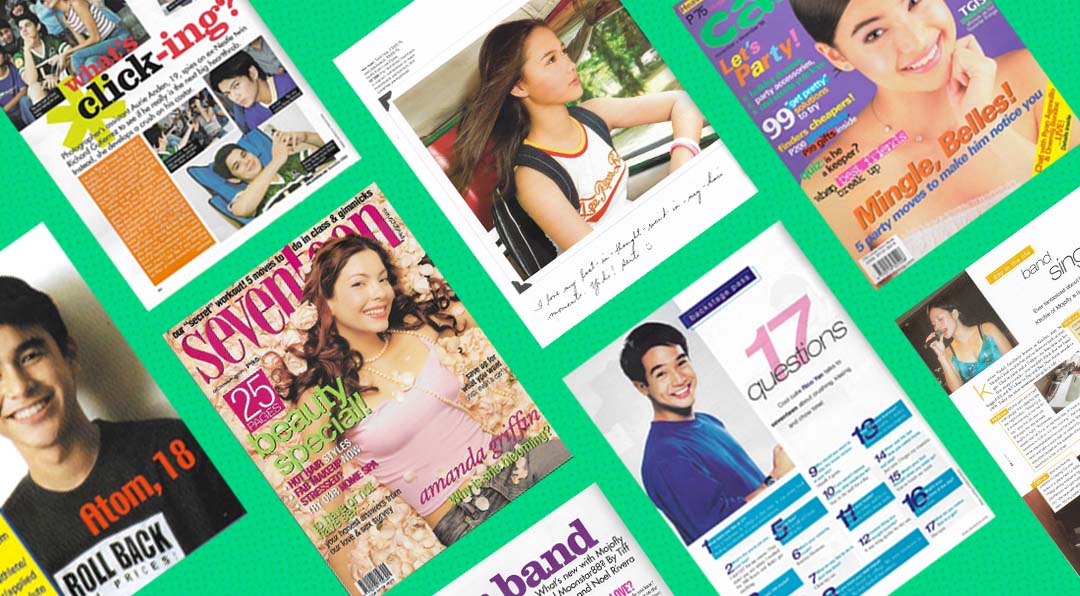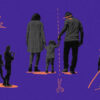Buying a magazine off the rack and the thrill that comes with it used to be staples in many mall excursions and convenience store stops by teens. Those glossy pages were once the main arbiters of cool and owning issues was something of a status symbol.
Luckily for those who miss physical copies of local youth magazines, Twitter page Magasin Archive (@glossyarchive) is reminding us what our first loves looked like—and what they look like now without rose-colored glasses.
Magasin Archive is run by 27-year-old writer, editor, and youth culture columnist Fiel Estrella who’s had bylines in titles like our sister brand Scout. It features scans from Estrella’s personal collection of mostly Filipino youth and culture magazines from the ’90s, 2000s, and new ’10s.
With Estrella’s editorial eye and penchant for weaving fun personal anecdotes and clever present-day parallels into the posts, Magasin Archive offers more than just blasts from the past. It is also a space to really digest what we’ve lost (like obsolete tech and late celebrities) and examine where we’ve grown (stepping away from orientalism) or declined (fewer pieces from affordable local labels in fashion spreads).
We sat down with Estrella to talk about Magasin Archive’s genesis and what running the account has made her realize about our local Y2K pop culture zeitgeist and publishing scene.
Tell us a bit about Magasin Archive and your journey into serious magazine collecting.
I’m a fan of sassyscans on Tumblr and thankyouatoosa on Instagram—two accounts that post scans from American teen magazines from the ’80s to the early 2000s. In January this year, I was looking through my things and found a collection of pages torn out of magazines like Teen Vogue and Nylon [as well as] piles of Candy and Seventeen issues lying around. I realized that nobody’s really doing that for American mags from the 2010s and, more importantly, Filipino teen magazines. So I thought it would be cool to start an archive of sorts.
I have a lot of magazine origin stories. My uncle worked at Mega so he always brought home copies of Meg for us. The first magazine I discovered for myself was the first issue of W.I.T.C.H. at a supermarket. As for Candy, I would “borrow” (read: take without permission) from my Ate’s stash when I was 8 years old.
🇺🇸 teen vogue profiles up-and-comer tom sturridge, 23 (december 2009-january 2010) pic.twitter.com/BacfUJqqqc
— magasin archive (@glossyarchive) September 9, 2022
But I started taking it seriously—religiously visiting newsstands at the beginning of every month and becoming a Booksale and Filbar’s regular—in 2005 when I was 11. It’s a wonderful memory to come back to: figuring out your own tastes, learning about all these interesting things and people, developing your own opinions on which titles were worth tucking away your allowance for month after month.
I looked up to the editors of the magazines I read so much and I’m so happy they decided to share so much of their process and team dynamic with readers in their letters and behind-the-scenes stuff. I’m lucky I wound up working in publishing myself, because it meant that I got to cross paths with a lot of them.
quiz: how jologs are you? (seventeen, july 2001) pic.twitter.com/7V2IITq4lO
— magasin archive (@glossyarchive) September 2, 2022
The collection I have right now doesn’t actually have any of the original issues of Filipino titles that I had as a kid through to my teens—I’d let go of them when I was foolish and thought I’d outgrown them. About five years ago, I entered a phase where I would look on eBay or Carousell for old copies of all my favorites growing up, and I came across a listing for dozens of the rarer early 2000s issues at a decent price. Currently my collection of magazines has grown to about 80 issues.
What are your fave titles and what’s your most prized issue?
My holy trinity is Candy, Seventeen, and Meg—they each mean a lot to me for different reasons. [But] my most prized issue is an issue of Sassy magazine from October 1989—it has a yellow cover, the cover line only says “Exactly” in bright red and all caps, and it has an interview with River Phoenix!
camera ads in teen philippines introduce the benefits of “going digital” (december 2001) pic.twitter.com/CFstgSWlJJ
— magasin archive (@glossyarchive) September 4, 2022
When it comes to local titles, you’ll have to pry my copies of Teen Philippines from my cold dead hands because it’s so rare and short-lived and I’m always wondering why it had to fold so early.
14-year-old anne curtis shares her favorite things (candy, november-december 1999) pic.twitter.com/VeIBFRUny3
— magasin archive (@glossyarchive) September 25, 2022
I also recently bought my first and only 1999 copy of Candy, so that was pretty cool. And my little pile of Meg issues pre-supersizing when it was only 5×7 inches.
What’s the biggest deciding factor for you when purchasing an issue?
The local secondhand magazine market is a little bit less affordable these days (issues go for as much as P500), so I’ve had to pace myself lately. I’ve been focusing on issues from 2004 and earlier because beginning 2005, I found that I’m less compelled by the styling and the design because late 2000s maximalism and “recessionista” fashion was taking over and it looks a little tacky, to be honest (laughs).
stylist and fashion editor anne bella recalls the shoot for this massive 12-page spread: done guerilla-style on manila streets with no permits, photos post-processed to get the lomo effect years before it was cool. i am truly obsessed with this one.
🔗 https://t.co/mKvwRRewSB pic.twitter.com/HhmHmPC0nd
— magasin archive (@glossyarchive) September 22, 2022
Aside from the publish date, I look at the cover person. It really is helpful that magazines used to be so in-your-face with their cover lines when it comes to features and celebrities. Right now though, I’m most interested in documenting fashion editorials (when I never paid them any mind as a kid), so I try my best to find issues with really good ones.
headcanon: these belong in the @IDILYmovie universe, obviously pic.twitter.com/aWrrUk0Bh7
— magasin archive (@glossyarchive) September 2, 2022
Which artists or brands do you think encapsulate Y2K in the Philippines best?
Going through all of these magazines made me realize how somewhere along the way—probably when imported brands began to take over malls with supersized stores and especially when online shopping became more common—I stopped paying attention to whether certain local brands were still around: Human, Pink Soda and Blue Soda, Bayo, YRYS, even Kamiseta and Kashieca. It was slightly bittersweet to see how magazines really championed these homegrown brands in their editorials, which you don’t really see now.
“prepped for school” shot by toto labrador, on location at be connected internet cafe (meg, june 2002) pic.twitter.com/I16PuVGsvP
— magasin archive (@glossyarchive) September 1, 2022
If there’s one shop that I could visit again that I think encapsulated the era perfectly and was ahead of its time, it would be Anonymous: minimalist showroom, cool and flattering gender-neutral clothing, fun and functional little knick-knacks like candy and storage items. Come back!
If you could go back in time and do a celebrity interview for one of the titles, which celeb would you pick and why?
Oh, there are so many. The hosts of Disney Buzz. Mandy Moore in her Penshoppe era (which coincided with her queen-of-teen-movies era). Amanda Griffin because she owned real estate on every magazine cover. Sandara Park. Lalaine Vergara-Paras. Kitchie Nadal (maybe a joint bestie interview with Barbie Almalbis, who I’ve been lucky enough to have actually interviewed). And, of course, Rico Yan.
rico yan gives two whole pages’ worth of valuable boy advice (candy, december 2000) pic.twitter.com/iX21yiBYnq
— magasin archive (@glossyarchive) September 19, 2022
You’ve tweeted about how teen mags and matinee idols seemed to have an obsession with fangs and fetishes at the time. What other weird and surprising details have you come across?
Not all of these pages have aged gracefully for sure. I’ve been so excited about sharing certain celebrity interviews, for example, and then I’d do research on the subjects and find out that their lives or reputations have taken a turn, you could say.
the one issue i've found also proves that some fashion editorials age better than others 💀 (although i do love the use of the manila orchidarium as a location) pic.twitter.com/X0654rUqiV
— magasin archive (@glossyarchive) September 23, 2022
I always laugh to myself when I find fashion pages that fall under the era’s obsession with “oriental” styling and the title would always be something like “Turning Japanese.” “Hard-hitting” pieces exaggerated the effects of smoking pot, anti-abortion sentiments were more common, and stories like “I thought I was gay” presented the idea of sexuality as more scandalous than it is. But a lot of them were written with a lot of care and objectivity, and I still think they’re such important snapshots of the problems teens faced at the time.
seventeen follows kitchie nadal around for a day as she juggles college classes, counter-strike, and rocking out (april 2001) pic.twitter.com/6Sq3z6g1VQ
— magasin archive (@glossyarchive) September 22, 2022
I also like looking up people and places and it pinches at my heart when I see the place has closed down, or a certain model is now a realtor or a paralegal somewhere far away. I’m constantly realizing how long 20 years is.
Which aspects of youth and culture magazine content are you happy and sad to see go?
When I started out in publishing, print was on its last legs. So there were a lot of things I never got to experience as part of an editorial team, one of them being the elaborate fashion shoots that really required trips to fun locations. They still take place sometimes, but they’re uncommon enough (especially for youth titles) that I mourn them a little.
“in the pink” shot by toto labrador on location on corregidor island (seventeen, november 2002) pic.twitter.com/QCtJqBc1ZJ
— magasin archive (@glossyarchive) September 14, 2022
I also noticed that you find less “life guide” or “how-to” content lately. Now it’s all about personal essays and culture pieces. Maybe a case of readers wanting more resonance now, to relate, rather than guidance. There’s a certain sense of earnestness that went away, but maybe it means that they need less coddling.
two of these jobs are pretty much obsolete/vastly different than before 🥲🥲 (candy, july 2003) pic.twitter.com/T327eEQINT
— magasin archive (@glossyarchive) September 14, 2022
But some aspects that I’ve been happy to observe have remained are the way these publications continue to shed light on hidden gems in our cities and interesting people doing cool things. They’re still pushing the voices of young people to anyone who’s willing to listen.
What’s the biggest cultural similarity or difference from then and now that you noticed while browsing your collection?
A great thing I noticed about the people who follow @glossyarchive is that while I post “girls’ magazines,” a lot of them aren’t actually young women. It’s cool to see that content aimed at young women also appeals to a wider audience [today].
the youth of edsa dos on what comes after overthrowing an abusive government (seventeen, may 2001) pic.twitter.com/eStl5Z7a1w
— magasin archive (@glossyarchive) September 21, 2022
As far as similarities go, I think these magazines are more progressive and alternative than they’re given credit for. They covered tough “taboo” topics with kindness and an open mind (most of the time, like I’ve said) and they had moments featuring unlikely bands, subcultures. Things teens worry about are timeless and unchanging, even if they come in different packages as time goes by.
Magasin Archive has gained a pretty interesting roster of followers. What do you hope people would get or realize from your posts?
One of the funnier quote-retweets I’ve gotten is “May Seventeen magazine tayo dati?!” It’s surreal because it used to be such a staple publication, but it did fold in 2009. Someone also said that they just realized magazines are just what Twitter is now.
My primary goal with this project is accessibility: to share these scans with people who once had them and miss them, and with people who missed out and are curious. I want to put forth the same things I feel when I browse the magazines: “This was ahead of its time,” or “This aged badly,” or really just “This looks super cute!”
i’ve lived to see countless technological advances and yet it still amazes me that there used to be a show you could call into—hosted by ‘click’ cast members—that let you control game sprites live on national television using your landline keypad ☎️ pic.twitter.com/4krLrHReZ6
— magasin archive (@glossyarchive) September 17, 2022
Editors and other publishing folk, some of whom actually worked on these issues, also followed the account. It’s wonderful to realize through this that people still care about print and that it can keep inspiring people on a vastly different platform. If anything, I’m happy to remind everyone and hear their stories about how magazines have raised and affected us, and how they can still do it now. I wouldn’t be who I am today without them, so this is just me keeping that love and creativity alive any way I can.
Art by Ella Lambio
Follow Preen on Facebook, Instagram, Twitter, TikTok, YouTube, and Viber


